I cannot believe this is our last day at G.T. Over the past three weeks I had the opportunity to observe and support in a grade one and Kindergarten class. I am so fortunate to have had this opportunity to gather resources and lesson ideas to support students reading and writing skills from three wonderful teachers. Below are detailed connections to the BC Curriculum, the lesson details and my reflection in relation to the professional standards for BC educators for a lesson that stood out to me over the last three weeks that will support my students reading in the future.
Overview
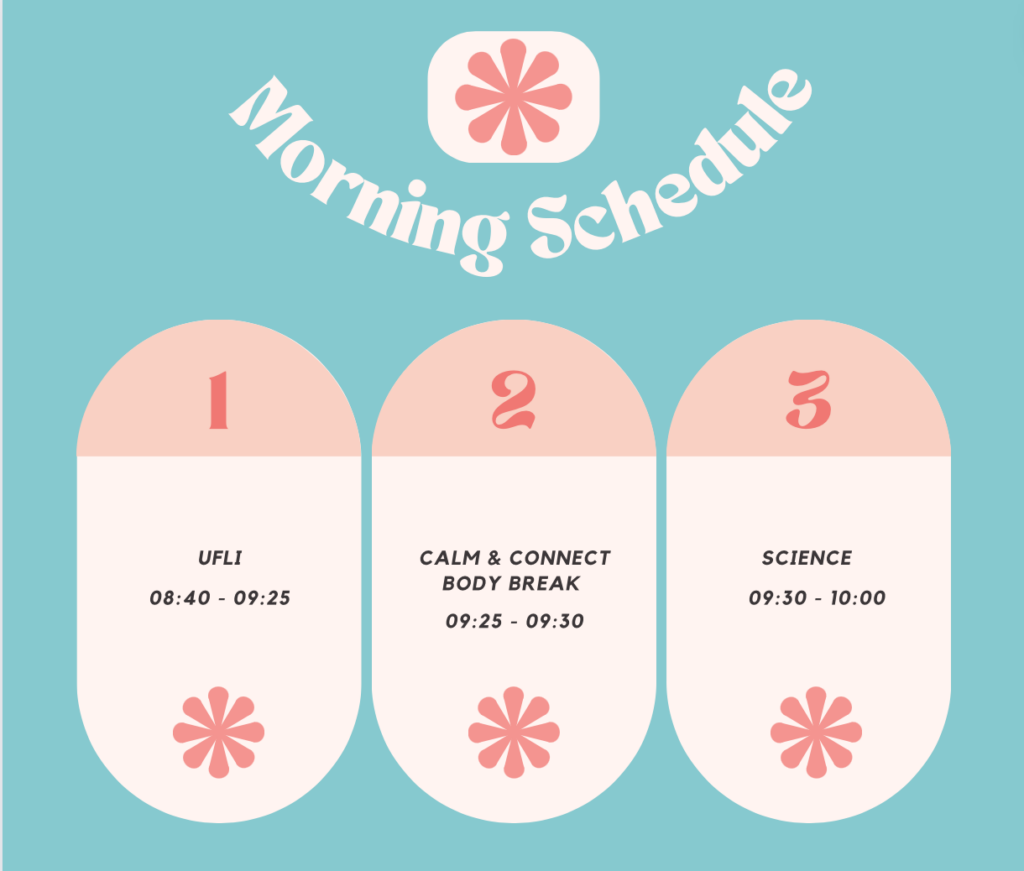
Connections to the BC Curriculum
Grade: 1 with Mrs M and Miss B.
Subjects: English Language Arts & Science
ELA Big Idea: “Playing with language helps us discover how language works” (BC Curriculum, 2024).
Science Big Idea: “Living things have features and behaviours that help them survive in their environment” (BC Curriculum, 2024).
ELA Curricular Competencies:
- “Use foundational concepts of print, oral, and visual texts” (ie. “concepts include directionality of print, difference between letter and word, difference between writing and drawing, spacing, letter-sound relationship, and phonological awareness”) [BC Curriculum, 2024].
- “Communicate using letters and words and applying some conventions of Canadian spelling, grammar, and punctuation” (ie. Using CAPS to review work) [BC Curriculum, 2024].
Science Curricular Competencies:
- Communicate observations and ideas using oral or written language, drawing, or role-play
- Experience and interpret the local environment
ELA Content:
- “Reading strategies: using knowledge of language patterns and phonics to decode words; identifying familiar and “sight” words” (BC Curriculum, 2024).
- “The concepts of print: ie. the correspondence of spoken words to printed words (one-to-one matching), the association of letters and sounds, the distinctive features of letters and words, the correspondence between uppercase and lowercase letters, left-to-right directionality, the use of space to mark word boundaries, the use of specific signs and symbols for punctuation (e.g., period, exclamation point, question mark) [BC Curriculum, 2024].
- “Phonemic and Phonological awareness: Phonemic awareness is a specific aspect of a learner’s phonological awareness: a child’s ability to segment spoken words into phonemes (e.g., c / a / t) and to blend phonemes into words indicates a developing phonemic awareness. Phonological awareness involves the abilities to hear and create rhyming words, segment the flow of speech into separate words, and hear syllables as “chunks” in spoken words” (BC Curriculum, 2024).
Science Content:
- “Names of local plants and animals” (both the Ktunaxa and English names) [BC Curriculum, 2024).
- “Specific properties of materials allow us to use them in different ways” (ie. one plant was used for mosquito repellant) [BC Curriculum, 2024).
- “Local First Peoples’ knowledge of the local landscape, plants and animals” (ie. In this lesson the teacher reviewed 3 local plants and how the Ktunaxa Peoples’ used them) [BC Curriculum].
Cross-Curricular Connections: The UFLI lesson is a critical foundation to have that will be used across all subject areas. The science portion of the morning would tie in well to Social studies 1: “Natural features of the local environment” (BC Curriculum, 2024).
Connections to FPPL:
- “Learning recognizes the role of Indigenous knowledge” (FPPL, 2024). I feel that this one specifically ties into the science portion of the lesson where students learned the Ktunaxa names for three local plants and their functions to Indigenous Peoples’.
- “Learning involves patience and time” (FPPL, 2024). This one ties more into the UFLI portion of the lesson as these foundational skills take years to develop.
Lesson Details
UFLI
- The teacher started by saying good morning to everyone in Ktunaxa (kiʔsuʔk wiǂnam _____) as she went down the attendance list.
- Began UFLI lesson #58 (See below images).

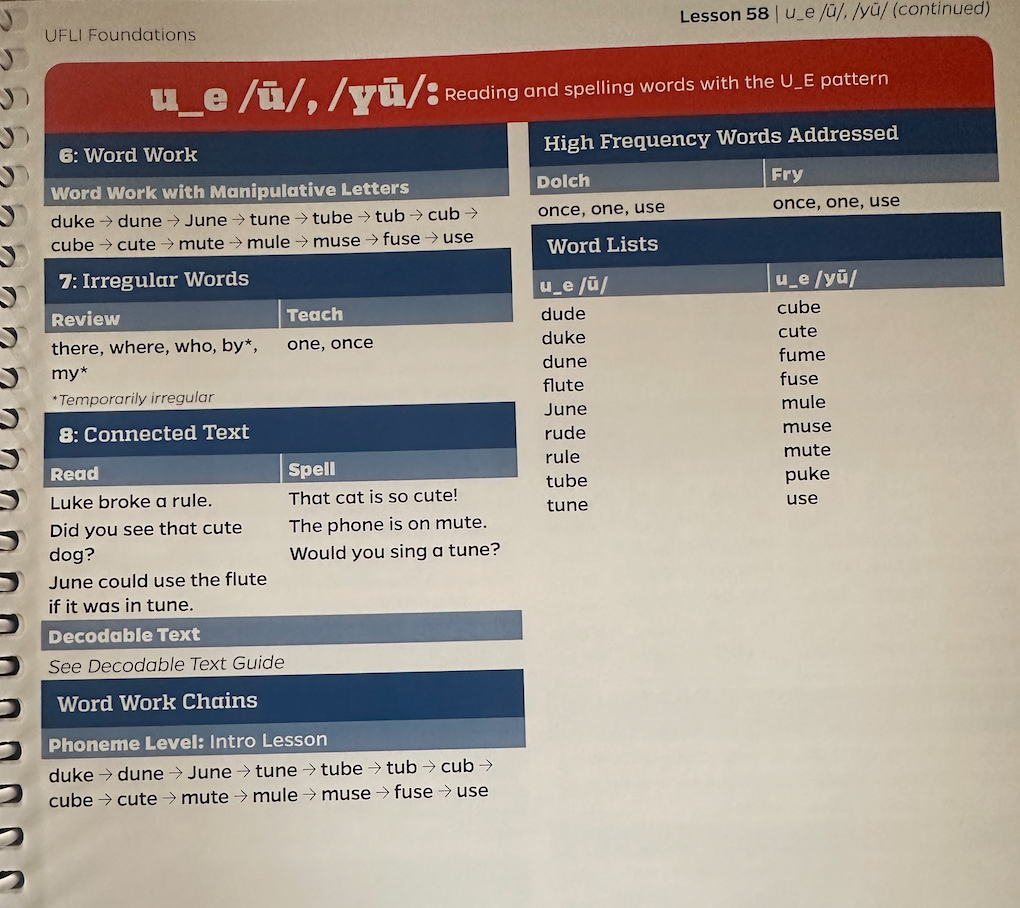
3. Uncover the u_e and u_ue sounds on the sound wall (see below photo):
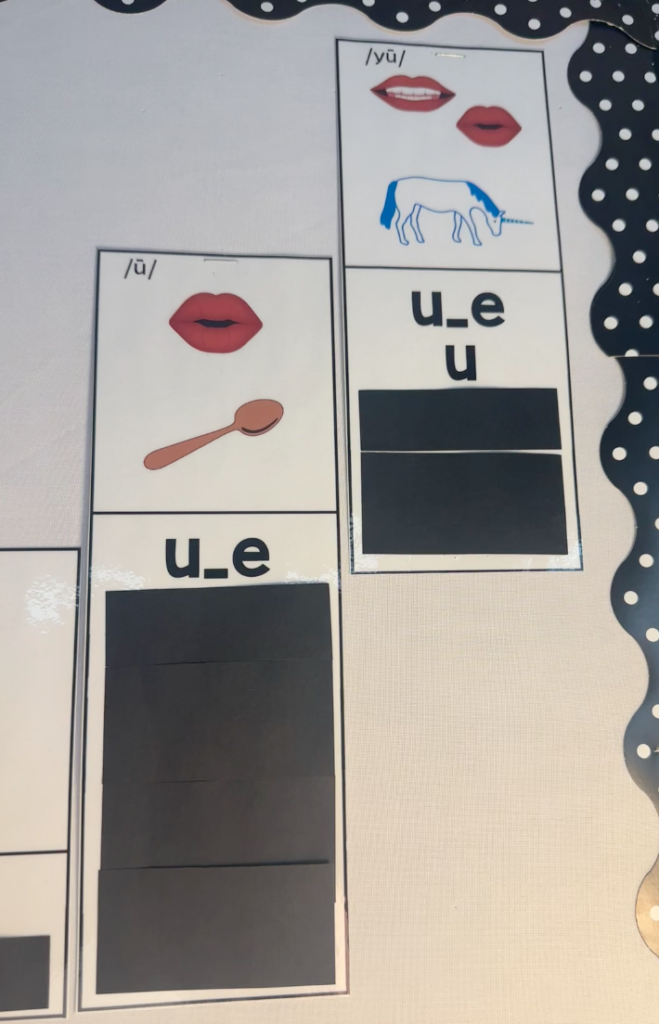
4. Students worked on blending words with blending boards. For example, the teacher would say your first word is d/u/ke and the students would follow by moving their letter and digraph tiles to make the blended word: duke. The teacher then modelled this under the projector. Next, students were asked to change one letter (for example, change the k to an n.. what is the word now? Dune). Students worked on blending for about 15 minutes. See the below photo of the boards they used.

5. Next, we gathered as a class on the carpet to go over heart words. I looked on the UFLI website and they have a wonderful PDF resource of all the Heart words that you can print off. See the following link: https://ufli.education.ufl.edu/wp-content/uploads/2022/09/UFLI_Heart_Word_Printable_Cards.pdf. Students were asked to spell the heart word “one” then spell the heartwood “once”. After each word they were able to dance along to the word with a sight word song website! The website is called HeidiSongs.TV. It does have a paywall of $5.99/month; however, I think for this grade it would absolutely be worth it as they were motivated and engaged to follow along with the songs.
6. Students then read a paragraph together as a whole group (Step #8 connected text in the lesson #58 details above). Students then worked on spelling one sentence together (“That cat is so cute!”). The teacher then gave students a sentence to work on independently on their whiteboards (“The phone is on mute.”). Students first wrote it, then checked it all together as a group and then checked for CAPS= Capitalization, all sentences make sense, punctuation, spelling. I loved that the teacher modelled CAPS and explained every step as students practiced their writing. See the below photo as an example of this activity:
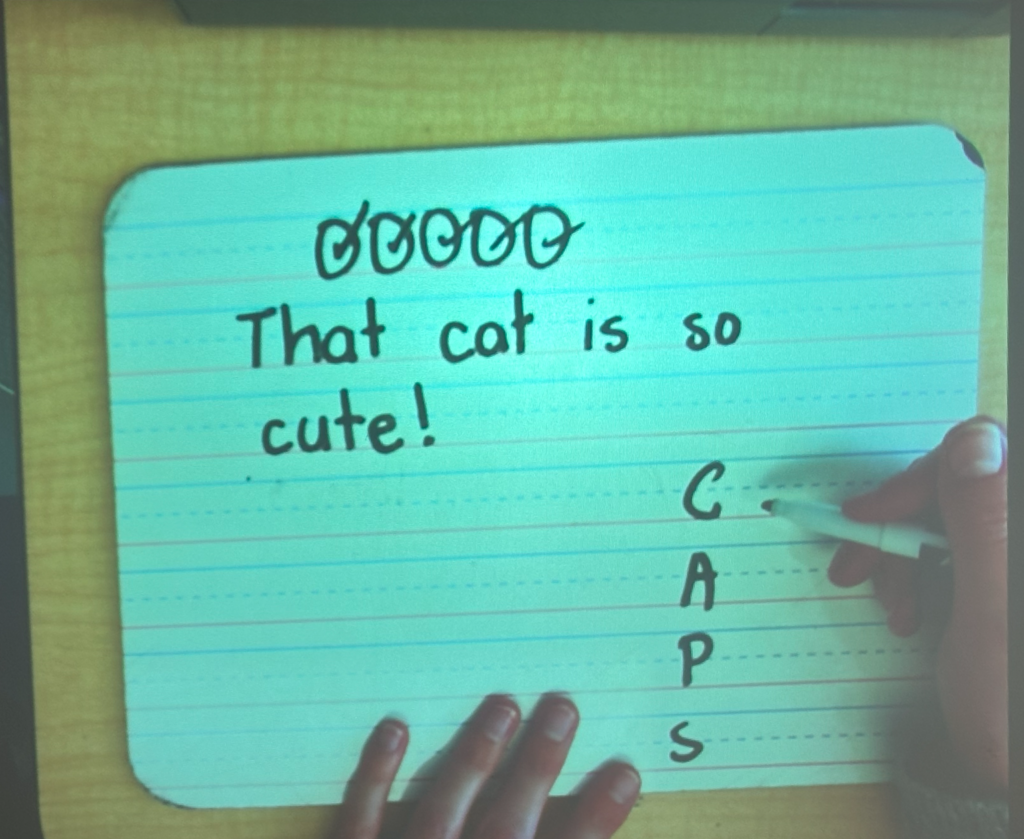
7. Lastly, the teacher reviewed the “decodable text” paragraph with the students by completing a choral read. The teacher emphasized the importance of volume, pace, and tone while reading aloud.
8. DRUMROL………..!!!! Today’s Rockin Readers are__________. This was a great reward system that gave students a “Rockin Reader” ticket if they showed outstanding participation and voice during UFLI that day. What I loved is that each student who was awarded a ticket, the rest of the class replied with “Good job ___(name)____! This was a wonderful way to show good sportsmanship and build classroom community by being happy for others.
*******************************************
Students were now given a 5 minute brain break with a platform called CalmConnect! Below I have embedded a video that provides a 5-minute introduction into what CalmConnect is and why it is impactful in the classroom:
Although this program is also behind a paywall ($99/year) this is something I would strongly advocate for in schools. It allows students to get up and moving but rather than getting more energized it helps them regulate to be ready to move onto the next activity.
*********************************************
The last part of our morning was spent on a science lesson! This class had spent a day before we arrived learning the English and Ktunaxa names of three local plants, an interesting fact about each one, and learned about what they look like (characteristics). The plants they learned about were the Yarrow, Wild Onion, and Saskatoon Berry. Today’s focus was consolidating their learning by creating a book called “Plants Around Me”. See the below photos:

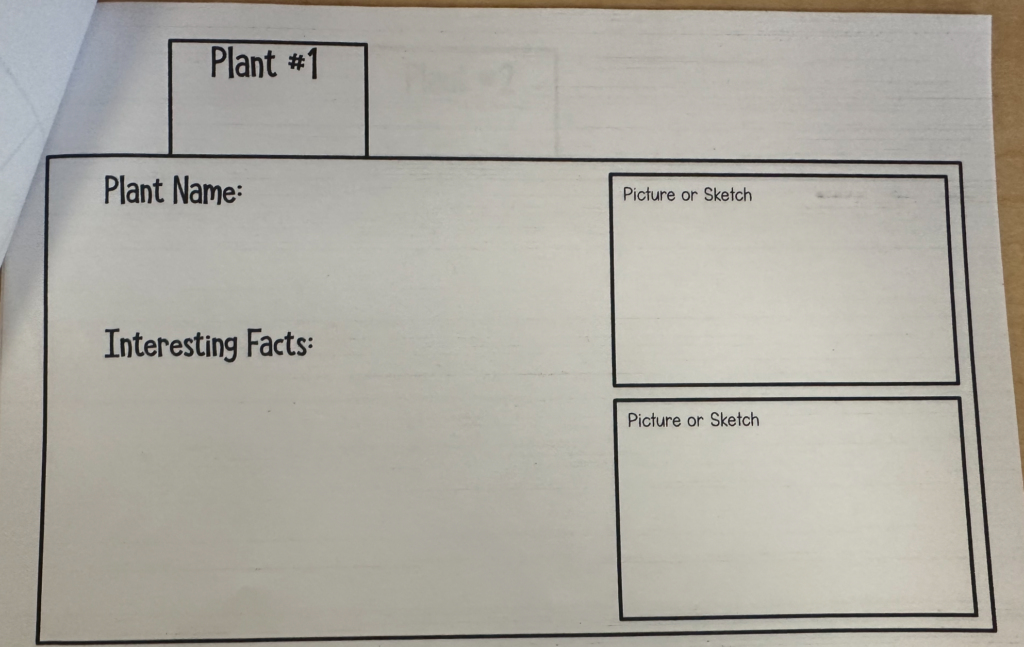
The teacher had a PowerPoint to breakdown each plant they learned and modelled how to write it into the booklet. She also had First Voices pulled up to remind students how to spell and say each plant name in Ktunaxa. Students followed along what the teacher was modelling under the projector to fill in the information to their individual books. It took the students about thirty minutes to write down 2 of the plants information. I could see this continuing for a few more classes to finish the third plant bio then editing, outlining, and colouring. I would love to do this down the road with my future students!
~Throughout this morning lesson I had the opportunity to meet so many wonderful students by circulating and supporting their learning by offering compliments and suggestions. They also taught me a lot about how to use the UFLI materials in their class!
Reflection: Related to the BC Professional Standards for Educators
Standard #7: “Educators Engage in Professional Learning”(BCT Professional Standards, 2024). After being immersed in a full UFLI lesson I was intrigued in learning more about how it works and how it is implemented in the classroom. I engaged in professional learning by going to the COTR library to see if they had the UFLI Foundations Book. I was in luck, they did have one!

I rented it out and had a read through parts of it. I discovered that it has an implementation guide for teachers! It took me step by step how to of how to use the lesson slides, UFLI apps, whiteboards, manipulative letter boards, how to prepare a classroom for UFLI sessions, and the core lesson plan features (see below photo). I felt that going through this book is setting me up for success when I need to teach UFLI in my practicum this spring. Below I have added a photo of the Core Lesson Plan Features that I found extremely helpful to breakdown each lesson.
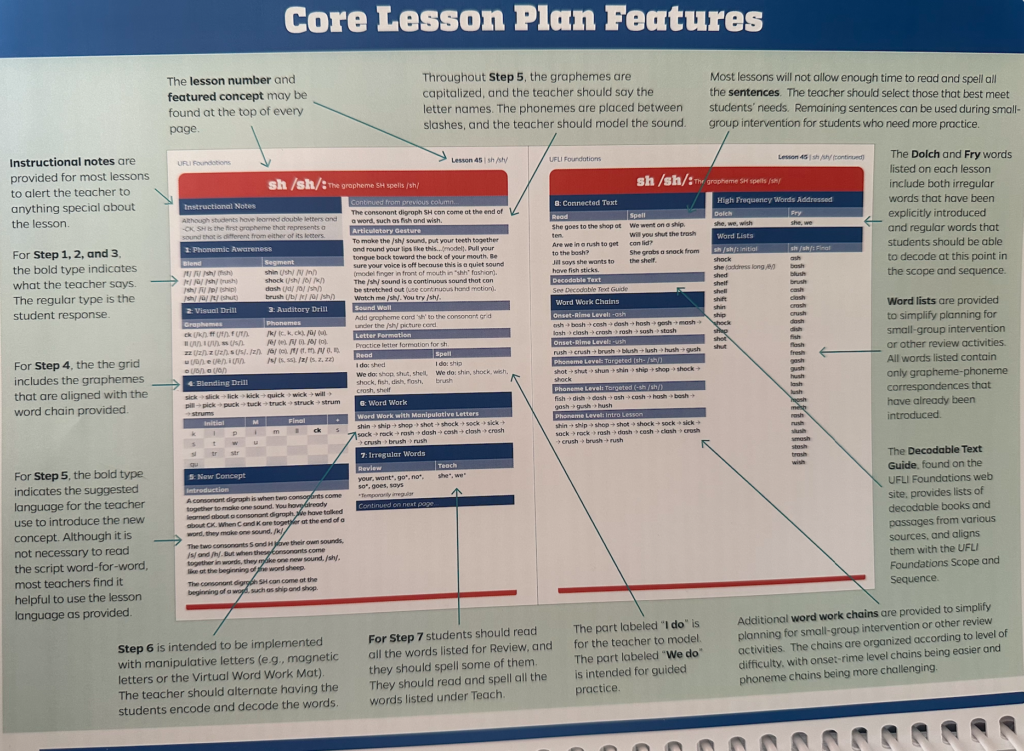
Lastly, I took some time to look around the UFLI website and even found an entire section of printable resources! This section included printable heart words, sound wall materials, grapheme cards, word work mats, and printable alphabet tiles (UFLI, 2024).
Standard #9: “Educators respect and value the history of First Nations, Inuit, and Metis in canada and the impact of the past on the present and the future. Educators contribute towards truth, reconciliation and healing. Educators foster a deeper understanding of ways of knowing and being, histories, and cultures of First Nations, Inuit and Metis” (BCT Professional Standards, 2024). I believe that I met this standard while participating in this lesson in the following ways:
a) I examined my own biases and values by reflecting on the lesson of local indigenous plants. I felt embarrassed that I did not know the names of these plants or their functions prior to this lesson even though I have seen them many times here on the Ktunaxa Territory.
b) I understand the importance of education for reconciliation. I hold myself accountable to take every learning opportunity I can to understand Traditional Ecological Knowledge (TEK) and weave this into my teaching of science. This past weekend I purchased the book “Braiding Sweetgrass for Young Adults” by Robin Wall Kimmerer, a Potawatomi botanist, as a way to bring TEK into my practicum class this spring. This will help students understand the importance of Indigenous knowledge, specifically, to protect the Ktunaxa Territory’s environment.
c) I plan to adapt/give credit to Miss. B for her lesson on creating a book of local plants. I hope to pass this new knowledge I have learned to my future students as a way to honour Indigenous Knowledge of local plants.
Reflection
Lastly, I wanted to complete a variation of the 3, 2, 1 reflection as a way to summarize my learning from this lesson experience:

The last 10 weeks at G.T have honestly flew by! I gained a lot of practical skills by being in the classrooms. The teachers and students taught me so much.. I am so grateful! I am sad this experience is over but I am excited that I have some tools to build from when I begin my first teaching job!
Thank you so much for following along!
~Chelsea
References
BC Curriculum. (2024). https://curriculum.gov.bc.ca/
First peoples principles of learning. First Nations Education Steering Committee FNESC. (2024). https://www.fnesc.ca/first-peoples-principles-of-learning/
Lane, H. B., Contesse, V., Pollett, C., Ricke, A., Taksier, K., & Madsen, K. (2022). UFLI foundations: An explicit and Systematic Phonics program. Ventris Learning.
Printable cards for irregular “heart” words – UF literacy … (n.d.-f). https://ufli.education.ufl.edu/wp-content/uploads/2022/09/UFLI_Heart_Word_Printable_Cards.pdf
Professional standards for BC educators – gov.bc.ca. (2024). https://www2.gov.bc.ca/assets/gov/education/kindergarten-to-grade-12/teach/teacher-regulation/standards-for-educators/edu_standards.pdf
Richter, E. W., Lawton-Shirley, N., Wilbarger, P., OTR, K. H., Culbert, Dr. T. P., Hopkins, D., Lackner, Dr. S., & Steele, Dr. W. (2023, November 9). Home. PrioHealth. https://www.priohealth.com/
Sing-along songs that teach. HeidiSongs. (n.d.). https://www.heidisongs.tv/
The UFLI Foundations Toolbox Is Live!. UF Literacy Institute. (n.d.). https://ufli.education.ufl.edu/
YouTube. (2022, January 25). An introduction to calmconnect. YouTube. https://www.youtube.com/watch?v=QtYzJNWJ90g
Leave a Reply
You must be logged in to post a comment.